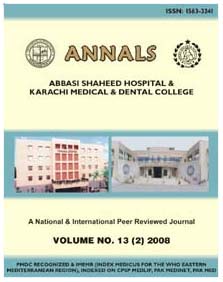
| |
| Home |
| Editorial Staff |
| Instruction to Authors |
| Journal-Issues |
| Policy |
| Copyright |
| BREAST FEEDING PRACTICES IN URBAN
IN RURAL AREAS OF PESHAWAR
*HAMZULLAH KHAN, **BALQIS AFRIDI ABSTRACT Objectives:Breastfeeding is superior to formula feeding because it has specific and non-specific factors that have long-term consequences for early metabolism and disease later in life. Present study was designed as to determine breast-feeding practices in urban and rural setup of Peshawar. Methods: A descriptive observational study was conducted in Palusi village (rural area) and Khyber teaching hospital Peshawar (urban area), from September 2005 to august 2006.Respondents was selected through stratified random sampling method. A total of 200 urban (100) and rural (100) women were selected. Of those we received complete set of information's from 80 urban and 60 rural women and they were further studies. Relevant information's were recorded from the respondents with the help of a pre-designed questionnaire. Results: Seventy percent of the urban and 83.33% of the rural women breast-fed their infants. Mixed breast-feeding and bottle-feeding recorded in (urban 22.5%, rural 11.67%). While bottle-feeding was recorded in (urban 7.5%, rural 5%) cases. Breast-feeding was initiated within first hour of birth (urban 66.25%, rural 51.66%), within 12 hours (18.75%, 23.33%) and after 24 hours (3.75%, 13.33%) cases. Exclusive breast-feeding was given to children for 4-6 month (urban 60%, rural 55%), for 6-8 month in (12.5%, 40%) and for less than three months in (27.5%, 21.66%) of the respondents. Complete two years breast feeding was given to children (urban 51%, rural 73.33%), and up to 6 months or less than that in (urban 10%, rural 3%) of the respondents. Weaning was started at 4-6 month age of the infants in (urban 76.26%, rural 81.66%) and at three months or below in (urban 8.75%, rural 3.33%). The distribution of reasons for not breast-feeding in urban and rural areas was: insufficient milk (70,63%, 63%), weakness (15%, 9.09%), job/student (urban 10%, rural 0%), and other problems not explained by the mother (5%, 27.72%). Conclusions: The breastfeeding rates urban were 70% and 87% in rural women.In rural setup initiation of feeding is slow. Urban women breast-fed their babies exclusively for up to 6 months while it shows variations in the rural setup. Furthermore rural women preferably give total breast-feeding to their children for two years duration. Main reason for not breast-feeding in both urban and rural areas is their complaint of insufficient milk. Key words: Breast-feeding practices, urban and rural women, Peshawar.
|
For Full text contact to:
|
|
*Final Year, MBBS, Khyber Medical College
Peshawar, Pakistan
|

Copyright © 2009 Abbbas Shaheed Hospital and Karachi Medical & Dental College.
All rights reserved.
Designed & Developed by: Creative Designers